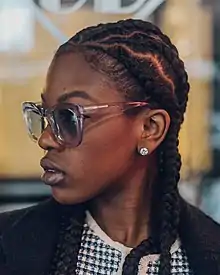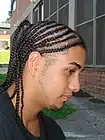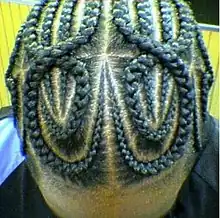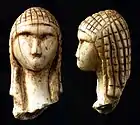Cornrows
Cornrows (sometimes called canerows) are a style of braids in which the hair is braided very close to the scalp, using an underhand, upward motion to make a continuous, raised row. Cornrows are often done in simple, straight lines, as the term implies, but they can also be styled in elaborate geometric or curvilinear designs.

Depending on the region of the world, cornrows are worn by both sexes, and are, on some occasions, adorned with beads, hair cuffs, or cowrie shells. The duration of weaving cornrow braids may take up to five hours, depending on the quantity and width.[1] Often favored for their easy maintenance, cornrows can be left in for weeks at a time if maintained through careful washing of the hair and natural oiling of the scalp. Braids are considered a protective styling on African curly hair as they allow for easy and restorative growth. Braids pulled too tightly or worn for longer lengths of time and on different hair types can cause a type of hair loss known as traction alopecia.[2]
History

The oldest known depictions of hairstyles that appear to be cornrows or braids are the statues known as the Venus of Brassempouy[3][4] and the Venus of Willendorf,[5][6][7] which date to 25,000-30,000 years ago and were found in modern day France and Austria.
Depictions of women with cornrows have been found in Stone Age paintings in the Tassili Plateau of the Sahara, and have been dated as far back as 3000 B.C. As well as the cornrow style is seen in depictions of ancient Cushitic people of the horn of Africa wearing this style of braids as far back as 2000 B.C.[8] The traditional hairstyle of Roman Vestal Virgins incorporated cornrows.[9][10][11]
The tradition of female hairstyling in cornrows has remained popular throughout Africa, particularly in the Horn of Africa and West Africa and the rest of Africa as a whole. Historically, male hairstyling with cornrows can be traced as far back as the early 5th century BC within Ancient Greek sculpture and artwork, typically shown on warriors and heroes. Artwork and statues of different Middle Eastern and Mediterranean civilisations dating back to the 3rd and 4th century BC also suggest that such hairstyles were common amongst warrior cultures. More modern male depictions occur in the 19th century Ethiopia, where warriors and kings such as Tewodros II and Yohannes IV were depicted wearing cornrows.
The name also refers to either the corn fields or sugar cane fields in the Caribbean.[12] It is most commonly held that this idea originated from Benkos Biohó during his time as a slave in Colombia.

Cornrow hairstyles in Africa also cover a wide social terrain: religion, kinship, status, age, racial diversity, and other attributes of identity can all be expressed in hairstyle. Just as important is the act of braiding, which passes on cultural values between generations, expresses bonds between friends, and establishes the role of professional practitioner.[13]
Cornrows have made a comeback in the United States in the 1960s and 1970s, and returned again during the 1990s and 2000s. In the 2000s, some athletes wore cornrows, including NBA basketball players Allen Iverson, Rasheed Wallace, and Latrell Sprewell.[14] Many female mixed martial artists who have more than jaw-length hair choose to wear cornrows for their fights as it prevents their hair from obscuring their vision as they move.
Controversy

Over the decades, cornrows, alongside dreadlocks, have been the subject of several disputes in U.S. workplaces, as well as universities. Some employers and educational institutions[15] have considered them unsuitable and banned them.[14] Employees and civil rights groups have countered that such attitudes evidence cultural bias, and some disputes have resulted in litigation.[16]
In 2011, the High Court of the United Kingdom, in a decision reported as a test case, ruled against a school's decision to refuse entry to a student with cornrows. The school claimed this was part of its policy mandating "short back and sides" haircuts, and banning styles that might be worn as indicators of gang membership. However, the court ruled that the student was expressing a tradition and that such policies, while possibly justifiable in certain cases (e.g. skinhead gangs), had to accommodate reasonable racial diversities and cultural practices.[17]
In the US state of California, the CROWN Act was passed in 2019 to prohibit discrimination based on hair style and hair texture.[18]
Gallery
 Styled cornrows
Styled cornrows Cornrows
Cornrows Artistic braiding
Artistic braiding
References
- "Cornrow Braid Styles". Africanamericanhairstyling. Archived from the original on 26 July 2018. Retrieved 11 August 2018.
- "Braiding 'can lead to hair loss'". BBC News. 24 August 2007. Retrieved 30 April 2010.
- Randall White (December 2006). "The Women of Brassempouy: A Century of Research and Interpretation" (PDF). Journal of Archaeological Method and Theory. 13 (4): 251–304. doi:10.1007/s10816-006-9023-z. S2CID 161276973..
- "Echoes of the Past: Prehistoric Wonders in Southern France". France Today. 30 September 2021. Retrieved 16 May 2022.
- "Woman from Willendorf" Archived 2007-10-05 at the Wayback Machine. Christopher L. C. E. Witcombe, 2003: "The rows are not one continuous spiral but are, in fact, composed in seven concentric horizontal bands that encircle the head and two more horizontal bands underneath the first seven on the back of the head."
- Shaw Nevins, Andrea (2006). The embodiment of disobedience : fat black women's unruly political bodies. Lanham, MD. ISBN 978-0-7391-5457-1. OCLC 856869915.
{{cite book}}: CS1 maint: location missing publisher (link) - Shell, Ellen Ruppel (2003). The hungry gene : the inside story of the obesity industry (1st Grove Press ed.). New York: Grove Press. ISBN 0-8021-4033-5. OCLC 53434322.
- Willie F. Page, ed. (2001). Encyclopedia of African history and culture: Ancient Africa (prehistory to 500 CE), Volume 1. Facts on File. p. 36. ISBN 978-0816044726.
- León, Vicki (2013). Working IX to V : orgy planners, funeral clowns, and other prized professions of the ancient world. New York. p. 18. ISBN 978-0-8027-1862-4. OCLC 879285569.
{{cite book}}: CS1 maint: location missing publisher (link) - "Oldest Roman Hairstyle Recreated for First Time". LiveScience. 9 January 2013. Retrieved 13 February 2019.
- "Ancient Roman Vestal Virgin hairstyle re-created for very first time". Gizmodo. 11 January 2013. Retrieved 16 May 2022.
- Charlotte Mensah (29 October 2020). Good Hair: The Essential Guide to Afro, Textured and Curly Hair. Penguin Books Limited. p. 42. ISBN 978-0-241-98817-6.
- "History of Cornrow Braiding: African Origins 1.b". Csdt.rpi.edu. Archived from the original on 23 June 2015. Retrieved 20 June 2015.
- Sherrow, Victoria (2006). Encyclopedia of Hair: A Cultural History. Greenwood Publishing Group. p. 97. ISBN 9780313331459.
- Harris, Sherry. "Cornrows: History, Controversy & Freedom of Expression". Sherry's Life. Archived from the original on 14 August 2016. Retrieved 28 August 2016.
- Alison Dundes Renteln (2005). The Cultural Defense. Oxford University Press. p. 143. ISBN 9780195154030. Retrieved 10 August 2011.
- "School braids ban 'not justified'". The Independent. 17 June 2011. Retrieved 17 June 2011.
- "California becomes first state to ban discrimination against natural hair". www.cbsnews.com. 4 July 2019. Retrieved 13 May 2021.